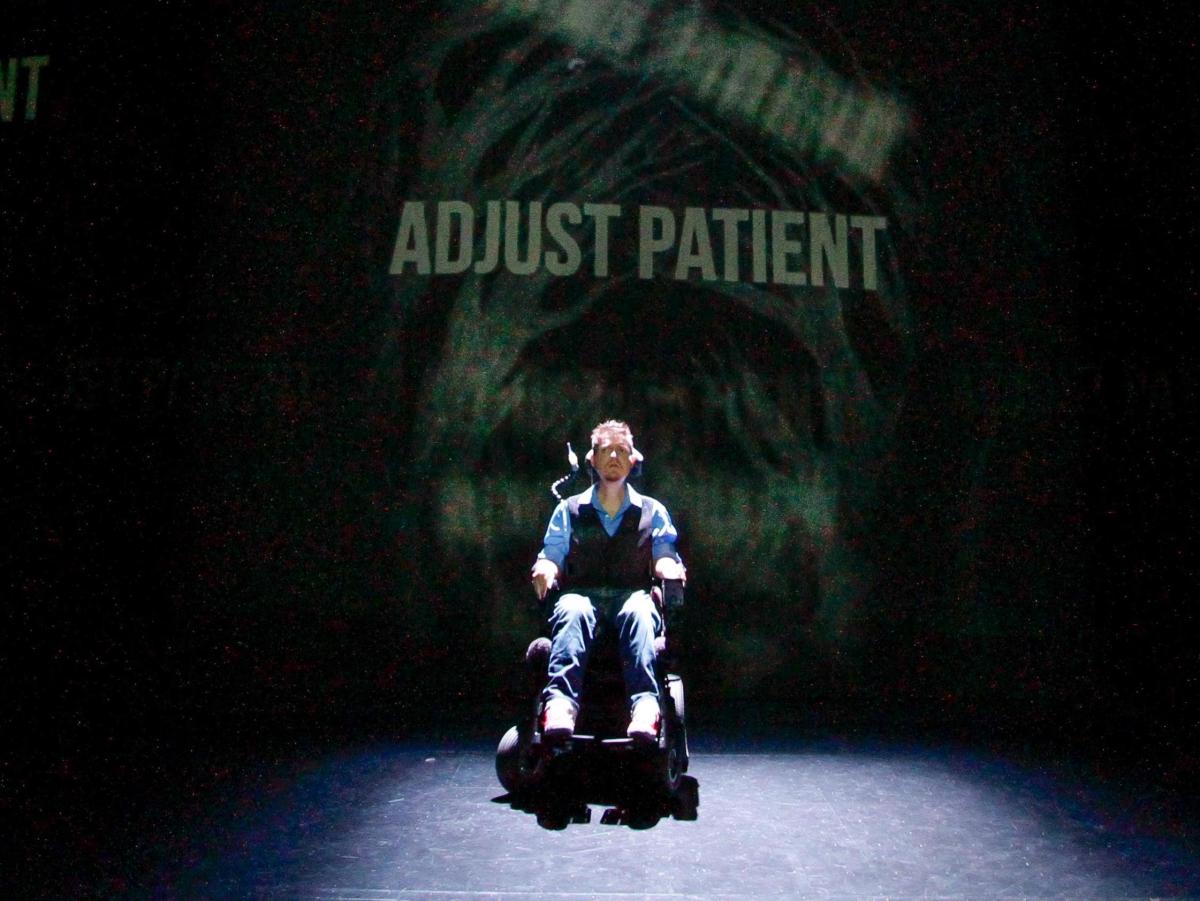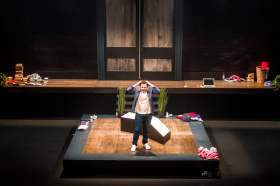Image: Romy Photography
We have all been asked at one time or another to stand in another man’s shoes. Cleverly, the publicity for this play asks us to take a ride in another man’s wheels. The man in question is Doug Robins, an engaging twenty-six-year-old with Duchenne Muscular Dystrophy. This is his story, told on stage by himself with courage and complete honesty.
Robins’s account lasts one hour, during which time he is the sole visible performer, assisted only by a set of unseen voices representing people he has met over the course of his life. It is a dazzling performance, marked by a sense of humour which is at once laconic and sardonic. There are laughs aplenty, interspersed with moments of pathos and deep insight.
The play (actually more of a multi-media presentation) is carefully constructed to engage the audience in the experience of being a Duchenne sufferer, but also to shape that experience so that there is a progression from the physical to the mental, and, finally to the spiritual aspects of Doug’s persona. For it is his persona that is created in this piece, rather than the actual man you might meet offstage, and therein lies the strength of the writing, the direction and the stage presentation.
It is not necessary to know much about Duchenne before seeing the play. That information is incorporated into the play, richly converted into a theatrical masterpiece of storytelling. The first thing the audience sees on entering the theatre is a set consisting of a number of stylised elements: tree shapes made of wire mesh at left and right, a bare acting area front stage, with a projection screen behind it, centre stage.
Then Robins appears quietly in his wheelchair. As the piece progresses the screen is revealed as a see-through scrim that comes to represent a forest. He can enter it from time to time. That’s the set – deceptively simple, minimalist. The designers, Simone Tesorieri and Simona Cosentini well knew how effective this would be in giving Robins’s story a symbolic dimension, and it works beautifully.
The next element to be revealed is the digital projection on to the screen which accompanies the action of the play. It starts with a dispassionate account of the progression of the disease and culminates in a fantastical depiction of a centaur, symbolising heroic endurance, at the end. Fashioned by Kyle Wilson, this is a skilful blend of the digital and the emotional – the pictorial and the symbolic. It adds considerable depth to Robins’ performance.
Trish Molloy’s sound design adds yet another dimension, underscoring the changes of mood and emphasising moments of deepened suspense as the story unfolds. This creative team is further enhanced by Suellen Maunder, the director, whose knowledge of Robins’s achievements – combined with a totally dispassionate treatment of the subject – provide the impetus for this remarkable presentation.
Robins himself is a very fine actor. The audience is totally captivated by his personality – even when the script leads him to challenge them outright: ‘What do you think when you see me? The first thing?’ Then, to make the point that we are more alike than different: ‘I will tell you this –shit happens. My shit is Duchenne. What’s yours?’
Given that acting is Robins’s chosen career, it is not surprising that he should, in the course of thinking about his condition, recite the famous speech from Hamlet, and apply it to himself: ‘To be, or not to be: that is the question’. With a prognosis of premature death at the age of twenty-five, who wouldn’t ask that question? Especially if one had already passed that marker. Apart from the tension-relieving humour of his internet dating or his attempts to deter unthinking offers of assistance, what engages the audience most of all, I think, is his rugged determination to just get on with life. As he says: ‘It’s not the chair that propels me. It’s what’s inside’.
The audience gets to feel Robins’s sense of determination and achievement, and to empathise with him in a way that would not be possible outside the theatre. A narrative account might make interesting reading, a film might portray the visual aspects of the condition, and perhaps look for an emotional response, but only the theatre with its unique bond between actor and audience can provide the kind of experience that this first night audience enjoy. Little wonder that they greet the conclusion of the play with a standing ovation.
Jute has once again shown conclusively that there are intriguing stories to be told right under its nose. In the process they have created a must-not-miss theatrical event.
Propelled
Writer: Jane Modric
Director: Suellen Maunder
Performer/Writer: Douglas Robins
Jute Theatre Company
Centre of Contemporary Arts, Abbott St, Cairns
www.jute.com.au
31 January – 8 February





